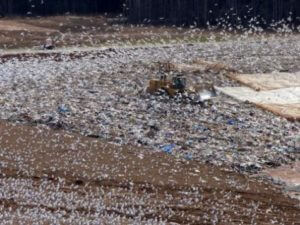DURHAM, N. C. — Scavenging seagulls don’t only raise a ruckus, but their poop pollutes our waterways, a new study finds.
Researchers at Duke University used both empirical data and their own hunches to estimate the number of landfill-dwelling seagulls in North America, finding that while the popular figure was 1.4 million, it was likely closer to five million.

Examining the loading of nutrients from two large drinking reservoirs near landfills in North Carolina — Jordan Lake and Falls Lake — the researchers used this data to estimate the total amount of phosphorous and nitrogen in bodies of water across the continent.
Their conclusion through extrapolation was that gull feces was responsible for the transportation and deposit of 240 tons of nitrogen and 39 tons of phosphorous a year into North American lakes and reservoirs.
Since the nutrients in birds’ droppings can result in a body of water seeing increased algal blooms and oxygen deprivation, the researchers warn of a number of consequences, including fish kills, increased government expenditure, and reduced ability to catch seafaring creatures.
“It costs local U.S. governments an estimated $100 million a year in nutrient offset credits to address or prevent the problem and maintain nutrient levels at or below the total maximum daily load threshold for water quality,” adds researcher Mark River, a doctoral student at the school, in a Duke news release.
Mind you, this estimate is based off of the low-range figure of there being 1.4 million of the seabirds.
“The idea that gull feces can be a major water quality problem may sound comical— until you look at data from an individual lake,” acknowledges Scott Winton, the study’s lead author. “In Jordan Lake, for instance, we found that a local flock of 49,000 ring-billed gulls deposit landfill feces containing nearly 1.2 tons of phosphorus into the lake annually.”
Neutralizing this phosphorous has cost the local government, both directly and indirectly, about $2.2 million a year, he notes.
Winton proposes a handful of solutions for this preventable problem, including reducing the size of gull flocks, minimizing the space used for landfills, and properly covering any trash on the sites.
“There’s a decent history of local governments implementing gull management at landfills because of fears about airplane strikes or because of the nuisance factor to nearby communities,” he concludes. “It might be cost-effective to pursue some of these non-lethal mitigation methods to reduce nutrient loading, as well.”
The study’s findings were published in the Oct. 1 edition of the journal Water Research.

Everything is wrong and bad and dangerous, isn’t it….
Seagulls & pigeons are just are just rats with wings